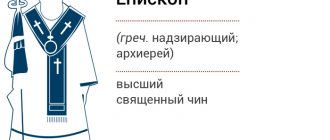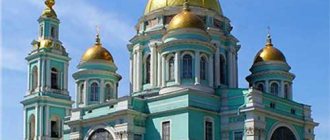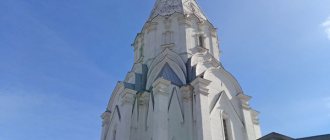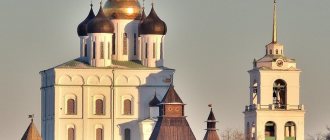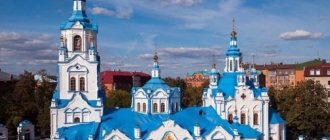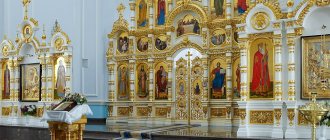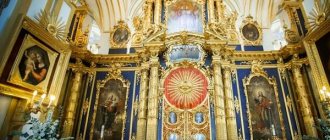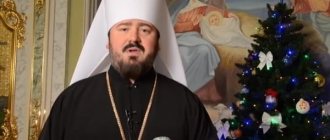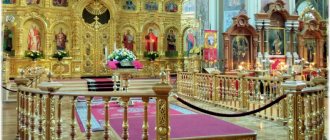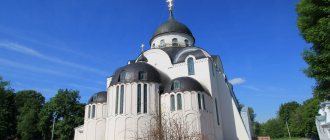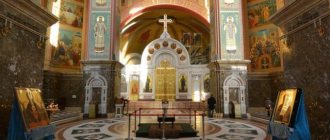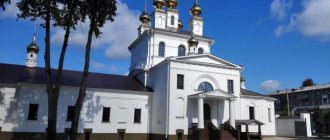History of construction
The Yelokhovskaya Church has a long, difficult, and full of dramatic moments fate.
Basic period of construction
In 1698, residents of the village of Elokha erected a small prayer room made of wood, and a little later, during the reign of Tsar Peter I, a stone structure was erected on this site (1717 - 1722). In the 30s, in honor of the Annunciation of the Virgin Mary, a chapel was added to it. By the end of the 18th century, other extensions appeared - a bell tower and a refectory. But Moscow is growing rapidly at this time, it becomes crowded during services, people coming from nearby and remote areas of the city cannot get inside.
We decided to begin construction of a new large temple structure. The architect E. Tyurin was entrusted with preparing the project. There were not enough funds, so construction continued for a very long time, but services were also carried out during construction or finishing work.
Subsequent restorations
By 1845, the construction of the main part of the structure, which was crowned by five domes, was completed. With the help of parishioners, mainly thanks to donations from the merchant Shchapov, the church was completed. In 1853 it was consecrated by Philaret, Metropolitan of Moscow and Kolomna.
A few years later, the upper tiers of the bell tower were built; in the 19th century, a dome was erected on the refectory, and attics were erected on the side facades. The height from the foundation to the cross and the bell tower is 56 m, area is 1164 sq. m, can accommodate 3000 people at the same time.
Modern arrangement
The most significant restoration was carried out in the late 60s of the twentieth century, which lasted 20 years. A huge amount of painstaking work was done. The floor was replaced with marble, the gold leaf covering was updated, and the pulpit was equipped with a bronze fence. The iconostasis was restored, and the wall paintings were cleaned and strengthened. They raised the floor under the altar and soles (raise). The balconies were refurbished, adding a central one, and a room was allocated for singers. We equipped elevators and conducted a broadcast so that believers could better hear the service.
The façade and roof were repaired. We landscaped the area and reconstructed residential buildings, dining rooms, and organized a place for the blessing of water. The restoration was carried out under the leadership of the chosen headman - N.S. Kapchuk.
History of the cathedral
The first documentary evidence of the existence of a wooden church in the village of Elokhov is an entry dated August 24, 1698 in the books of the patriarchal government order. The Yelokhovskaya church was rebuilt several times during the reign of Peter I’s father, Alexei Mikhailovich Tishaysh. Alexey Mikhailovich was a religious man, strictly observed fasts, and knew the liturgical regulations very well.
Yelokhovsky Cathedral in Moscow
But a particularly active life began when, at the end of the 17th century, a German settlement appeared nearby, and artisans and townspeople settled in Elohovo and worked in the houses of foreigners. Then the population began to increase, and somehow the temple became famous.
The last time the church was rebuilt was during the lifetime of Peter’s mother, Tsarina Natalya Naryshkina, the second wife of Alexei Mikhailovich. But each time rebuilding or re-building a new church was an expensive and thankless task. Therefore, in 1712, fundraising began for the construction of the stone Epiphany Church. Such arbitrariness could be punishable.
By order of Peter I it was forbidden to build stone churches and monasteries. There was a rapid construction of St. Petersburg: both brick and stone from all over the country were sent to the new capital. However, the king not only turned a blind eye to this, but also personally donated bricks for the construction of a stone church in a German settlement.
And such a temple was erected, however, much later, in July 1731, at the expense of Princess Praskovya, the younger sister of Empress Anna Ioannovna, niece of Peter I.
And the modern building was built relatively recently - in the middle of the 19th century. The temple grew like a person to become ready for service during the difficult years of persecution of the Russian Orthodox Church.
The bell tower was erected in 1806. Saint Philaret took an active part in the reconstruction of the church. When the borders of Moscow expanded and the number of parishioners grew, it became obvious that the old Epiphany Church, built a hundred years ago, could no longer accommodate believers.
About other churches in the capital:
- Church of the Exaltation of the Holy Cross
- Temple of the Apostles Peter and Paul
- Temple of St. Alexander Nevsky
At the origins of the idea of building a new Epiphany Cathedral were Elokhovsky priests: Archpriest Alexander Pokrovsky and Nikita Karpov. One of the largest architects, academician of architecture Evgraf Tyurin, agrees to build the temple. Elokhovsky Cathedral, built in the late Empire style, became significant, but the last serious creative milestone of Evgraf Tyurin.
Many years of construction work and interior decoration began, which were carried out with voluntary donations from parishioners. During repair and construction work, divine services were not interrupted and were held in the warm refectory part of the church near the Annunciation and St. Nicholas thrones.
Elokhovsky Cathedral, view from the south side
The fact that such a magnificent temple, almost in the center of Moscow, was not looted and destroyed can be called a miracle that is given by the faith of people. Since the 20s of the 20th century, the authorities have made repeated attempts to close the temple. Here they wanted to make first a barracks, then a book depository, then a museum. And even completely demolish it under the pretext of constructing a metro. But the believers defended their shrine.
During the times of repression, when out of fear a husband abandoned his wife, and children abandoned their parents, 4,800 people were not afraid and signed against the closure. Moreover, these were not just squiggles, but a full indication of the name, address, place of work, otherwise the signature was considered invalid. These people accomplished the feat of confessing faith, and the temple was saved.
Important! When the Cathedral of Christ the Savior was razed from the face of Russia, the Epiphany Cathedral became the heart of the Orthodox country.
History of the name
According to Moscow legend, back in the 14th century there was a dense alder forest and the Olkhovka River and Olkhovets Stream (now enclosed in pipes) flowed through. As stated in Dahl's dictionary, the names alder and elokh have the same root. Obviously, this gave the name to the village of Eloh, located not far from the forest, known since the reign of Demetrius Donskoy.
It is famous for the fact that St. Basil the Blessed was born here in 1469 and lived for 83 long years, a man who was not afraid to denounce even Ivan the Terrible, pointing out the cruelty of the ruler. They escorted the saint on his last journey with honors and buried him at the Trinity Church on Red Square, which has since received the name of St. Basil.
God's servant Alexander is baptized...
The architecturally impeccable building of the Yelokhovsky Cathedral stands out clearly in the dense and varied Moscow buildings. You cannot pass by this amazingly beautiful temple without noticing. And the first thing you learn when you are about to open the massive door and enter the cathedral: Alexander Sergeevich Pushkin was baptized here. A memorial plaque testifies to this. It was thanks to the metric book of the Epiphany Cathedral that the birthplace of the Russian poet was established. For a long time, it was considered the house of the titular adviser Skvortsov at 40 Nemetskaya Street, where the Pushkins rented an apartment. But in fact, Pushkin was born in house No. 4 on Malaya Pochtovaya Street, from where he was brought to the Epiphany Church at eight days old. At that time, the Yelokhovsky Cathedral did not yet have its majestic appearance and status: it acquired it after the death of the poet.
The first documentary evidence of the existence of the Church of the Epiphany in Elokhov dates back to 1694. In 1712–1731 it was rebuilt in stone. The village of Elohovo bordered on the German settlement, and according to legend, Peter I personally donated bricks for its construction. Among the benefactors are famous figures of the Peter I era, including Grand Duchess Praskovia Ivanovna, the daughter of Tsar Ivan Alekseevich and the sister of Empress Anna Ioannovna.
The solemn consecration of the stone Church of the Epiphany in Elokhov on July 4, 1731 was performed by Archbishop Leonid of Sarsk and Podonsk. In 1789–1790, a major reconstruction of the temple was carried out. In 1792, the chapel was consecrated in the name of St. Nicholas the Wonderworker. In 1793 - the chapel of the Annunciation of the Blessed Virgin Mary. In 1805, the construction of the bell tower was completed.
But even with the advent of new chapels, the Epiphany Church could not accommodate all the parishioners, so it was dismantled, and in 1837, according to the clergy register, construction of a new building began. Moscow architect E. D. Tyurin was invited to construct it. During construction work, services for parishioners were not interrupted and were held in the refectory, at the Annunciation and St. Nicholas thrones. In 1845, the construction of the grandiose main building of the temple was completed, and its interior decoration began, which lasted for eight years.
One of the main temple builders and benefactors of the newly built Elokhov Church was the Moscow 2nd guild merchant, hereditary honorary citizen Vasily Ivanovich Shchapov. The great consecration of the cathedral on October 18 (old style) 1853 was performed by Metropolitan of Moscow and Kolomna Philaret (Drozdov).
In the pre-revolutionary years, outstanding Moscow church hierarchs, the metropolitans of Moscow and Kolomna: St. Innocent (Veniaminov) and St. Vladimir (Epiphany) performed divine services in the Epiphany Cathedral. At the solemn memorial service held in the church in 1899 in memory of the 100th anniversary of the birth of A.S. Pushkin, the Grand Duchess and Martyr Elisaveta Feodorovna prayed.
Architecture
The building was built in the Empire style. The main part is cube-shaped, with five domes installed at the top. The domes have the shape of rotundas with window openings. The rotunda in the center is decorated with elaborate paintings. The building is decorated with pilasters and portals from the north and south. At the top there are wide semicircular windows resting on two columns. The structure, thanks to numerous elements, has a light and airy appearance.
The arches passing through the bell tower make the structure elegant and graceful. There are round columns at the corners of the upper tiers. The upper tier is not decorated; on top there is a dome covered with gold leaf, as well as a cross. The interior spaces are connected to the refectory by a small passage. The side façade is decorated with attics, and a baptismal sanctuary is built in the courtyard, where adults and children can undergo baptism.
Foundation and construction of the Epiphany Church
In 1731, through the mediation of parishioner Colonel Vorontsov, Peter I personally donated bricks for the construction of a stone church. With the generous donations of Princess Praskovya Ioannovna, the emperor’s niece, the Epiphany Cathedral was completed, and Elokhovo was decorated with a stone structure.
At the end of the 18th century, the Pushkin family became parishioners of Peter the Great's Epiphany Church. In 1799, Alexander Pushkin was baptized here, as evidenced today by a memorial plaque on the wall of the temple.
Peter's Cathedral stood until the middle of the 19th century, but this building also required reconstruction. The old church was dismantled to build a new, majestic and monumental one. The work was entrusted to the famous architect Evgraf Dmitrievich Tyurin.
According to the architect's project, 200 thousand rubles were required for the construction of a new church in the Empire style. The third part of the sum, fabulous at that time, was donated from personal funds by the merchant of the second guild, Shchapov. On October 18, 1853, the beautiful and elegant, grandiose five-domed cathedral, which had been under construction for 26 years, was consecrated by Archimandrite Philaret.
The domes shining with azure and gold and the Byzantine luxury of the Elokhov Church personified the greatness of Rus' and the dream of the high destinies of the Motherland.
Interior decoration
In October 1846, parishioners turned to the Holy Synod for permission to decorate the inside of the new, newly built building. With the help of parishioners, the interior is richly decorated, with golden colors dominating the design.
The ceilings and walls are richly decorated with fine paintings. By 1853, a multi-tiered iconostasis of complex shape, 18 meters high, was built on the eastern side. Masters of icon painting specially painted 65 images. Entering the room, a person involuntarily directs his gaze upward - to the image of the New Testament Trinity, depicted in the domed part of the central rotunda.
The majestic rotunda plays a dominant role in the interior, resting on huge supporting arches, which are supported by tetrahedral pillars and support the vault. The main altar is dedicated to the Holy Epiphany, there are two more chapels - on the left side it is installed in honor of St. Nicholas the Wonderworker, the right one is in honor of the Annunciation of the Mother of God. The painting of the cathedral walls was done in the first half of the 20th century by masters from Mstera, which is the largest center of icon painting.
Interiors and shrines
Thanks to 12 arched windows and double rows of openings in the walls, the Elokhovsky Cathedral is light, and its interiors look very festive. The dome is decorated with paintings on the theme of the New Testament Trinity, and the vaults are decorated with the faces of the four evangelists and scenes from the Gospel. The western wall of the temple is decorated with beautiful frescoes on biblical themes. The large altar contains paintings done by Afanasy Kulikov. Oil painting can also be seen on the vaults of the refectory.
The church houses a 17th-century icon of the Kazan Mother of God and a shrine made of metal alloy, revered by believers, in which lie the relics of Metropolitan St. Alexis of Moscow. In one of the aisles there is a white marble tombstone, made according to the design of Academician Alexei Viktorovich Shchusev, over the grave of Patriarch Sergius. On the southern and northern sides there are unusual banners that the Elokhovsky Church ordered in 1896 in honor of the coronation of Russian Emperor Nicholas II.
The pride and main decoration of the cathedral is a unique six-tiered iconostasis 18 m high, made in the neo-Byzantine style in the mid-19th century.
The intricate wooden carvings are gilded and look very impressive. The luxurious iconostasis holds 65 icons. The oldest of them were written in the 17th-18th centuries. The cathedral is famous for its rich sacristy, where silver altar crosses, Gospels with ancient engravings, old church books and precious liturgical vestments are kept.
The Cathedral today
Church life here has always been active, even in difficult times of persecution and oppression. In 1925, on the Presentation of the Lord, with the permission of Soviet leaders, Patriarch Tikhon held a festive liturgy. The building in 1926 received the status of “monument of church architecture” of the first category. Perhaps that’s why it wasn’t demolished and turned into a cinema or warehouse.
The new government did not close the center of Moscow Orthodoxy either at the beginning of its reign or in subsequent years, but this threat always hung over the ministers and believers. The first closure resolution was approved in the spring of 1930. 5 thousand parishioners signed a letter to the authorities asking for the cancellation of such a decision, and the request, oddly enough, was granted.
In 1935, they decided to refurbish the building and create a cinema, but this plan also did not come true. The last closure was scheduled for June 22, 1941. On this day, as you know, the war with Nazi Germany began, which prevented the authorities from implementing the decision. Metropolitan Sergius, immediately after the declaration of war, appealed to parishioners to go to the defense of the Fatherland from the invaders.
On the initiative of church ministers, a collection of funds for the defense of the country was organized. The Metropolitan set an example - he gave away a cross from his hood and a pectoral richly decorated with precious stones, donating them to the needs of the state in difficult times of war. Despite the authorities’ attempts to close the religious building, constant oppression and persecution, church ministers helped their country throughout the four years of war, collecting more than 835,000 rubles for defense and purchasing gifts for Red Army soldiers worth more than 500,000 rubles.
In the spring of 1942, with the permission of the authorities, a service was held for Holy Easter; more than 6,500 believers visited it. Since 1943, Metropolitan Sergius was elevated to the rank of Patriarch of Moscow and All Rus'. In 1945, the department passed to Alexy I, who, by decree, awarded the Church of the Epiphany the status of Patriarchal (retained until 1991). During the Patriarchate, important events for the Russian Orthodox Church were carried out - the enthronement of metropolitans, the transfer of the relics of St. Alexis from the Assumption Cathedral in 1947, and others.
With the Divine Liturgy celebrated in the church in 1988, festive events began to celebrate the millennium of the baptism of Rus'. Orthodox shrines were often exhibited for veneration - the relics of Seraphim of Sarov, the head of Panteleimon the healer, the “Vladimir” icon of the Mother of God. In 1991, the temple was given cathedral status, and in 1992, a memorial plaque was installed to the poet A.S. Pushkin, who was baptized here.
In 1990, a significant restoration was carried out, the internal territory was landscaped, and various economic services were located in the nearest houses (after the resettlement of residents). The ashes of Patriarch Alexy II, buried here in 2008, rest here. Today, the cathedral hosts daily services, Sunday and holiday services, a Sunday school and a church singing class.
The main shrines of the cathedral
The temple has gone through a lot, but it has preserved and increased its shrines thanks to its parishioners and the support of high dignitaries of the Church.
List of the icon of Our Lady of Kazan
The history of the icon is very instructive and interesting. According to legend, the archer Onuchin had a nine-year-old daughter, to whom the Mother of God came in a dream. She asked to inform the archbishop and mayors that her icon needed to be removed from the ashes of the Kazan Kremlin. And she even indicated the exact location. The girl was afraid to go to the city leaders, because she understood that no one was going to believe the child in such matters, because the parents did not believe. The Mother of God appeared both the second time and the third. That time, the Mother of God angrily threatened the little girl, if she did not obey, then She would ask for something else, and the girl would die. The frightened mother took her upset daughter to the governors in the city and Jeremiah, who was holding the post of Archbishop at that time. As the girl thought, no one believed her words.
On July 8, the child’s mother found helpers and, taking her daughter with her, headed to the ashes: since the city rulers do not want to fulfill the will of the Mother of God, then they will do it. So, obeying the girl’s instructions, they tried to unearth the sacred image, but all attempts were in vain until the girl herself took up the shovel. Right at the stove, she dug up an image of the Most Holy Theotokos wrapped in a cloth sleeve, which turned out to be clear, clean and bright, without any traces of fire on it.
When the archbishop and mayors learned about the miracle, they made a religious procession to the place where the face was found and took it to the Church of St. Nicholas of Tula, and then to the Annunciation Cathedral.
There are many lists of the icon of Our Lady of Kazan. However, the most revered ones are located in St. Petersburg and Moscow. It is this revered list that is located on the left side of the altar in the Cathedral of the Epiphany in Elokhov.
This list is miraculous and therefore helps many. Pozharsky went with him on a campaign against the Poles in 1611. In addition, the Mother of God began to be considered the patroness of the Romanov dynasty.
Kutuzov (after the defeat of the French) ordered the production of a silver iconostasis from the collected silver, which was to become a gift to the Mother of God.
The healings and mercies from the Mother of God for those who turn to her are simply innumerable. Usually people approach her with a request to bless the newlyweds for a happy family life.
The revered list spent many years in the Vatican. It was necessary to return her, and the Pope also wanted this. An obstacle to this were the conditions set by the Catholic Church, which included a personal meeting of the patriarchs, but the transfer itself was not considered a sufficient reason for this.
It was only in 2004 that the Catholic Church decided to remove all conditions. At the end of August, the venerated list was transferred to the Assumption Cathedral during the Divine Liturgy by a delegation of Catholics headed by Cardinal Walter Kasper.
Icon of the Mother of God “Recovery of the Lost”
This icon belongs to the ancient heritage of Christianity. She became famous back in the 6th century, as she became the reason for the salvation of the monk Theophilus from death in Adana, a city located in Asia Minor. Later, this husband took a place among the monks who achieved the highest spiritual perfection.
Already in the 18th century, this icon became famous in Russia. With her help, the peasant Feodot Obukhov was saved from death in the cold. He, freezing in a snow blizzard, prayed to the Mother of God, imagining her face, seen in the St. George Church, located in Bolkhov. A woman's voice called his friend, and he went outside, where he saw a sleigh and a horse harnessed to it. The frozen Theodotus lay on those sleighs. Then the saved one ordered a copy of the icon “Recovery of the Lost” for his parish church.
Many times the icon saved people by giving them a miracle. More than once and not twice, during cholera, they carried it out and went in procession to neighboring villages. With the advent of Soviet power, the face was lost.
The list now presented in the Church of the Epiphany in Elokhov can also be considered miraculous. It is usually called upon when someone is in danger of losing their life. Thus, thanks to her miracles, many human lives are saved.
Icon of the Mother of God “Joy of All Who Sorrow”
It is believed that the first miracle of the icon took place in 1688. At that time, Patriarch Joachim held a prayer service for the health of his seriously ill sister Euphemia. On November 6, a miracle of healing occurred. After this, many Christians reached out for help. Crowned persons were not spared attention and veneration. The list from it became one of the main shrines of St. Petersburg, where Natalya Alekseevna, the sister of Peter I, took it.
Now this icon is in the Cathedral of the Epiphany in Elohovo, so everyone can turn to God and touch the shrine.
Icon of Seraphim of Sarov
In the main chapel, to the left of the pulpit, there are particles of relics, a full-length icon of Seraphim of Sarov and the vestments of the hermit saint.
It is believed that both the future and the past of any person were revealed to the saint during his lifetime. He saw the thoughts and hearts of those around him, healed and instructed those in need of help. This shrine is addressed in the following cases:
- when it is necessary to help overcome temptations and gain the mental strength necessary to solve problems;
- when you need to find a balance between the internal and external world;
- when healing of soul and body is needed;
- if necessary, find your soul mate or strengthen existing family relationships;
- when there is a need for assistance in business matters.
People especially often turn to him to get rid of alcoholism and drug addiction. Miracles of healing are not uncommon. The main thing is to approach the image with a pure heart and an open soul.
Relics of Saint Alexy of Moscow
Archpriest Alexey Mechev lived relatively recently. On June 9/22, 1923, he left this mortal coil. He was buried at the Lazarevskoye cemetery in Moscow. Then his remains were transferred to the Vvedensky Mountains.
Many Christians visited the grave of Father Alexy. Hundreds and hundreds of them came here to get rid of sorrows and achieve enlightenment. Everyone left purified and filled with truly God’s peace.
Alexy was canonized 70 years after his dormition. His first glorification as a saint occurred on August 20, 2000.
After the relics of the new saint were delivered to the temple, endless lines of sufferers stretched to the shrine, wanting to find solace and peace of mind. By pouring out their sorrows, parishioners cleanse their souls and find true consolation.
Shrines and icons
Light from large windows falls on the images of saints located in a circle - Grand Duke Vladimir and Grand Duchess Olga, Alexander Nevsky, Sergius of Radonezh, Saints Michael, Peter, Blessed Basil and many others. The Kazan Icon of the Mother of God, which used to be in the Kazan Cathedral, is especially revered. In the main chapel there are icons:
- “Mammal,” which was sent as a gift from St. Athos in 1894;
- Mother of God “Seeking the Lost”
- “Deliverance from the troubles of the afflicted” – very rare and ancient
- in the Nikolsky chapel you can see a unique image of St. Nicholas the Wonderworker
- “Resurrection of Christ”
- In the main chapel - St. Seraphim of Sarov
The relics of St. Alexy were delivered in 1947 and met by Patriarch Alexy I. In 1944, Patriarch Sergius was buried in the northern aisle.
Cathedral during the Great Patriotic War
A collection of donations for defense needs was organized at the Epiphany Cathedral. In addition, the church provided significant material assistance to the front - more than 6 million rubles. During the war years there was an extraordinary rise in the religious feelings of believers.
A contemporary of those events, a parishioner of the Epiphany Cathedral, wrote that during the days of Great Lent in 1942 everyone wanted to confess and receive communion, there were so many people who wanted to fast that the priests were forced to give communion during the liturgies of their eminences - on Wednesdays and Fridays. On ordinary days for communion, especially on some Saturdays, so many communicants gathered that the service began at 6.30 and ended at 16.00-17.00.
Iconostasis of the Epiphany Cathedral
After a historic meeting with Stalin in the Kremlin on September 8, 1943, at a council of bishops, Metropolitan Sergius was elected His Holiness the Patriarch. Unfortunately, he did not have long to live.
On the night of April 4-5, 1942, city authorities allowed the Easter service to be held in the Epiphany Cathedral, which was attended by 6,500 Muscovites. And on May 18, 1944, on the days of Holy Easter, the cathedral again could not accommodate all the parishioners: this time people came to say goodbye to His Holiness Patriarch Sergius, who was buried in the Nikolsky limit.
Clergy
The clergy of the Epiphany Cathedral changed several times, always protecting the interests of the flock.
In the XX - XXI centuries, the rectors of the cathedral:
- Protopresbyter Nikolai Kolchitsky – from 1924 to 1961
- Protopresbyter Vitaly Borovoy – from 1973 to 1978
- Protopresbyter Matthew Stadnyuk – from 1978 to 2013, honorary rector since March 2013
- Archpriest Alexander Ageikin – March 24, 2013
The archdeacons who served here were: Georgy Antonenko (1943-1958); Vladimir Prokimnov (1963-1990); Stefan Gavshev – (1975-1990); Andrey Mazur - since 1990. These people, serving God, defended the interests of the Church in difficult times for it, when it was under pressure from the authorities. Largely thanks to their activities, the temple was saved from closure.
Pre-revolutionary life of the cathedral
Among Muscovites, the Epiphany Cathedral has always had a reputation as a “people's cathedral”, because its main parishioners were workers, peasants, small traders and merchants, as well as townspeople. However, the most famous parishioner of the Yelokhovsky Church was the poet Alexander Sergeevich Pushkin. So, on June 8, 1799, under No. 73, a record of his baptism was made in the parish register. A hundred years later, in 1899, the anniversary of the poet’s birth was solemnly celebrated in the temple. Already in our time, in 1992, a memorial plaque with the date of Pushkin’s baptism was placed at the entrance to the cathedral building.
Epiphany Cathedral in 1882
The Yelokhovsky Church survived the Napoleonic invasion of 1812 relatively safely. And although its sacristy was looted by French soldiers, the building itself was not seriously damaged, and the decoration was preserved from the fire. Towards the end of the 19th century, extensive charitable activities were launched at the cathedral. Thus, on the initiative of parishioners Matveev and Kamynin, a brotherhood was founded at the church to help the poorest parishioners, as well as an almshouse for 10 women and a shelter for 15 boys. In November 1875, a fraternity school opened for 35 boys. The Shchapov family of merchants played a significant role in the charitable activities of the temple. For example, Vasily Ivanovich Shchapov, being the head of the temple, bequeathed to him capital in the amount of 26 thousand rubles, which at that time was a considerable amount.
Where is it and how to get there
The cathedral is located on Spartakovskaya street, house 15, in the Basmanny district of the Central Administrative District of Moscow, Russia.
You can get there by metro:
- Go to Krasnoselskaya station, then walk along Nizhnyaya Krasnoselskaya street. Or take the tram, routes No. 37, 45, 50 to the Baumanskaya stop.
- To the Baumanskaya metro station, then walk along Baumanskaya and Spartakovskaya streets.
- Get to the Komsomolskaya metro station, then from the Bolshevichka Factory stop by bus No. 88 or trolleybus No. 22 to the Elokhovskaya Ploshchad stop.
The Epiphany Church is one of the few in Russia that managed to avoid closure and desecration; services have always been held in it. Believers will always find support and understanding here in joy and sorrow.
In Moscow we recommend the following hotels:
Favorite cathedral of Muscovites
The Yelokhovsky Cathedral in Moscow is not only famous, it is also very loved by Muscovites, it is often called “the cathedral of my childhood.”
This is also because it was never closed. The troubles of the dark years of persecution of the church passed it by, so many small residents of the capital were brought here by their grandmothers from afar, and for them the cathedral became home. It should be noted that in total during the war years, the Epiphany Elokhov Cathedral in Moscow transferred 835.9 thousand rubles for defense, and 535.1 thousand for gifts to soldiers. How much he had to endure! They wanted to demolish it in order to expand Elokhinskaya Square, turn it into a House of Rare Books or a cinema. But in times of any adversity, even in the days of revolutions and wars, the Elokhov Cathedral in Moscow did not close its doors. The Epiphany of the Lord or the Feast of the Epiphany is the day when the temple in Elokhov was consecrated. It is celebrated on January 18 and is the patronal one for the cathedral.
Epiphany Yelokhovsky Cathedral in Moscow on the map
- Ski resorts in Georgia
- Marina Bay Sands Hotel Singapore
- Liner Anthem of the seas – cruise prices
- 9 most romantic places in Europe
- Mediterranean cruises for 6 nights from €330 in April – Costa Cruises and MSC Cruises
- Holidays in Spain with children
- Basilica of San Lorenzo in Florence
- Where to relax in Turkey by the sea in June
- Visa to India on your own
- Dublin sights - 7 most interesting places
- 25 best parks in Crimea
- Sights of Prague
Subsequent restorations
Construction work continued further - in 1889, a dome and an attic (a decorative wall located above the cornice) were built above the refectory. According to Zykov’s design, only this and the first tier of the bell tower should have remained from the cathedral. After reconstruction, the cathedral became one of the most monumental religious buildings in Moscow. The next renovation of the interiors took place in 1912 - the cathedral was repainted. The gilded iconostasis has survived to this day. They bought the bell from the Bolshoi Theater and replaced the cracked one.
Modern arrangement
A very serious restoration of the cathedral began in 1969, after the election of N. S. Kapchuk as headman, who headed the repair and restoration work, which lasted for 20 years. As a result, a lot has been done: the gold leaf has been completely replaced and bronze fences have been installed on the pulpit and salt. All floors have been replaced with marble.
And under the altar and soles (in Christian churches - the raised floor in front of the iconostasis or altar barrier) the floor is raised. Wall paintings were washed, new stained glass windows were painted, and restoration workshops were built. It’s impossible to list everything. The cathedral is beautiful and fits well into the renovated center of Moscow. But opinions about the restoration are very different - from enthusiastic praise to the assessment of “samovarshchina”. Elokhovsky Cathedral in Moscow (the photo fully conveys the extraordinary beauty and proportionality of one of the central religious buildings of the capital) is a national architectural monument.
FIVE MONASTERIES AND TEMPLES WHERE THE RECENTS OF MOSCOW HIGH PRIESTS REST
On the day of conciliar veneration of the Moscow High Hierarchs, we invite our readers to briefly recall their great deeds and, with their mind’s eye, visit the resting places of their venerable relics. All of them are located in Moscow and the Trinity-Sergius Lavra, which is inseparable from the troubles and sorrows, joys and victories of our Capital City.
On October 18, the Holy Church remembers the council of Moscow saints, all glorified hierarchs who were in the Moscow see, Saints Peter, Alexy, Jonah, Macarius, Philip, Job, Hermogenes, Tikhon, Peter, Philaret, Innocent and Macarius, Moscow and all Russia miracle workers.
Assumption Patriarchal Cathedral of the Moscow Kremlin
The Assumption Cathedral was the tomb of Moscow metropolitans for three centuries from the beginning of its construction until the Synodal period in the history of the Russian Church. The relics of six first hierarchs, glorified as saints, rest in the Assumption Cathedral.
Saint Peter, first Metropolitan of Moscow (2nd half of the 13th century - 1326)
Saint Peter, first Metropolitan of Moscow (2nd half of the 13th century - 1326). In 1325, Saint Peter, at the request of Grand Duke Ivan Danilovich Kalita, transferred the metropolitan see from Vladimir to Moscow. This event was important for the entire Russian land. Saint Peter prophetically predicted liberation from the Tatar yoke and the future rise of Moscow as the center of all Russia.
Saint Jonah of Moscow (1390s – 1461)
Saint Jonah of Moscow (1390s - 1461) . On December 15, 1448, at the Council of Russian Bishops, he was elected Metropolitan of Kyiv and All Rus'. He lived permanently in Moscow and became the last saint to bear the title of Metropolitan of Kyiv. In 1459, by a conciliar decision, he established a new procedure for the election of metropolitan high priests - the Council of Russian Bishops with the consent of the Moscow prince. Thus was the beginning of the actual autocephalous Russian Church, which rejected the Florentine Union.
Saint Macarius, Metropolitan of Moscow and All Russia (c. 1482 - 1563) . In 1547 and 1549 convenes two Councils in Moscow, at which a lot of work was done on the canonization of Russian saints, and therefore, under the leadership of the Metropolitan, the lives of the saints - the Great Menaions - were compiled. Under him, in 1551, the famous Hundred-Glavy Local Council of the Russian Orthodox Church took place. Saint Macarius made a lot of efforts to organize the printing business in Rus'. Under him, the first printing house for printing sacred and liturgical books was opened in Moscow.
Saint Philip, Metropolitan of Moscow and All Russia, miracle worker (1507–1568) . He openly denounced Tsar Ivan the Terrible for establishing the oprichnina and executing innocent people, for which he was unjustly judged, exiled to the Otroch Assumption Monastery in Tver, where he was killed by Malyuta Skuratov.
Saint Job, first Patriarch of Moscow and All Rus' (c. 1525 – 1607)
Saint Job, first Patriarch of Moscow and All Russia (c. 1525 - 1607) . In 1586 he was elected Metropolitan of Moscow, and in 1589 he was proclaimed the first patriarch in Russia by the Patriarch of Constantinople Jeremiah II, who was in Moscow. After the death of Boris Godunov in 1605, he refused to recognize the legitimacy of the power of False Dmitry, was slandered and expelled from Moscow. Saint Job returned to the throne city on February 14, was greeted with honor, and on February 20 in the Assumption Cathedral he forgave and blessed his former flock. Thus, reconciliation took place between the patriarch and the people, who only a year and a half ago, in the same church, allowed the impostor’s minions to overthrow and insult the shepherd.
Soon after this event, on June 19, 1607, Patriarch Job died, surrounded by the care of his admirer, Archimandrite Dionysius of the Staritsky Assumption Monastery, the same one who ruled the Trinity-Sergius Lavra in troubled times.
Saint Hermogenes, Patriarch of Moscow and All Rus' (1530–1612).
Saint Hermogenes, Patriarch of Moscow and All Rus' (1530–1612). He was an ardent opponent of False Dmitry II and the Polish-Lithuanian interventionists. The Poles besieged in the Kremlin more than once sent to the Patriarch demanding that he order the Russian militias to move away from the city, threatening him with the death penalty. The saint answered firmly: “Why are you threatening me? I fear only God. If all of you, Lithuanian people, leave the Moscow state, I will bless the Russian militia to leave Moscow, but if you stay here, I will bless everyone to stand against you and die for the Orthodox Faith.” He died in captivity from hunger, before the liberation of Moscow.
IN. Morgun. The Poles lead St. Hermogenes to prison. Graduate work. 2008. Workshop of historical and religious. painting. Head I.I. Glazunov
Epiphany Cathedral in Yelokhov
Until the 1920s, the relics of St. Alexis rested in the Alexievsky Church of the Chudov Monastery, destroyed in 1929. Pyotr Baranovsky, a famous architect and restorer of ancient Russian architecture, managed to transport the relics on a cart to the Assumption Cathedral of the Kremlin before the demolition of the temple.
On October 14, 1947, at 5:40 a.m., the relics of St. Alexy, the Moscow Wonderworker, were delivered by Archpriest Nikolai Kolchitsky to the Yelokhovsky Cathedral and greeted by Patriarch Alexy I.
Reliquary with the relics of St. Alexis in the Yelokhovsky Cathedral. Built in 1948
Saint Alexy, Metropolitan of Moscow (between 1292/1305 - 1378) . For the sake of historical truth, it should be noted that Saint Alexy still bore the title of Metropolitan of Kyiv and All Rus', but in all church texts he is called the Metropolitan of Moscow and All Russia, the Wonderworker. Possessing exceptional intelligence and abilities, Saint Alexy was the de facto ruler of the Moscow principality under three Moscow princes. In 1366 he began construction of the stone Kremlin. The Metropolitan enjoyed great favor in the Horde, where he healed Khansha Taidula, who had an eye problem; contributed to the fact that the great reign was finally strengthened by the Moscow princes. Saint Alexy in Moscow founded the Andronikov Monastery in honor of the Image of the Savior Not Made by Hands, and began the construction of a stone church in the name of the Miracle of the Archangel Michael in Khoneh and with him the Chudov Monastery.
Cathedral Church of Christ the Savior
The Cathedral of Christ the Savior was founded in 1839 and consecrated in 1883. The temple building was destroyed at the height of the Stalinist reconstruction of the city in 1931. It was rebuilt and consecrated in 1994–2000. The facades of the temple were decorated with high reliefs on religious and historical themes, the subjects for which were chosen by Metropolitan Philaret of Moscow.
Cathedral Church of Christ the Savior
On June 9, 2004, the relics of St. Philaret were transferred from the Trinity-Sergius Lavra to the Cathedral of Christ the Savior in Moscow, where they currently rest in a shrine south of the Royal Doors of the upper church.
Saint Philaret, Metropolitan of Moscow and Kolomna (Vasily Mikhailovich Drozdov 1782–1867).
Metropolitan Philaret was one of the most educated people of his time. It is no coincidence that he had to become the main participant in great historical events in the life of not only the Church, but also the entire Russian Empire. Thus, Metropolitan Philaret played a key role in carrying out the act of succession to the throne from Alexander I to Nicholas I. Back in July 1823, on behalf of Alexander I, Archbishop Philaret, in the deepest secrecy, drew up a manifesto on the transfer of rights to the Russian throne from Tsarevich Konstantin Pavlovich to Grand Duke Nikolai Pavlovich; On August 16 (28), 1823, the manifesto was approved and, 11 days later, received by the saint in an envelope with the emperor’s own inscription: “Keep in the Assumption Cathedral with state acts until my demand, and in the event of my death, open to the Moscow diocesan bishop and the Moscow general -to the governor in the Assumption Cathedral before any other action.” When preparing the peasant reform in Russia and the liberation of peasants from serfdom, Emperor Alexander II insisted that the final version of the Highest Manifesto of February 19, 1861 be developed by Metropolitan Philaret.
Saint Philaret, Metropolitan of Moscow and Kolomna (Vasily Mikhailovich Drozdov 1782–1867)
While still at the St. Petersburg Theological Academy, the saint began the work of his entire life - the translation into Russian of the Holy Scriptures of the Old and New Testaments. However, only in 1856 was Filaret able to again raise the issue of the Russian translation of the Bible in the Holy Synod. The complete Russian Bible came out of print after his death.
Metropolitan Philaret loved the monastic way of life and strict statutory worship. During the administration of the Moscow diocese, with his blessing and tireless care, nine new monasteries and four monasteries, including Edinoverie ones, were founded. The saint took great care to convert the Old Believers from the schism to Orthodoxy. With the blessing of St. Philaret, three Orthodox monasteries were opened in the Moscow diocese in places where Old Believers settled, rites according to the “old rites” were approved with the remembrance of the current Church hierarchy - unity of faith, which, according to the saint, was supposed to remove obstacles for those wishing to achieve church unity of the Old Believers.
Trinity-Sergius Lavra
On October 10–14, 1994, excavations were carried out south of the Church of the Descent of the Holy Spirit on the site of the Church of Philaret the Merciful, demolished in 1938–1940. As a result of the excavations, the honest relics of St. Philaret of Moscow and St. Innocent were discovered. The relics of St. Innocent now rest in the Assumption Cathedral of the Trinity-Sergius Lavra. In 1880–1881 the basement part of the Assumption Cathedral was rebuilt into a crypt, where a temple was consecrated in honor of all the Saints who shone in the Russian land. Many hierarchs are buried here, including St. Macarius of Moscow (Nevsky). In the crypt of the cathedral, water blessing prayers are held (beginning at 9.00 and 12.00) and blessed oil is distributed.
Saint Innocent, Metropolitan of Moscow and Kolomna, Saint, Apostle of America and Siberia (Ivan Evsevievich Popov, then Veniaminov, 1797–1879)
Saint Innocent, Metropolitan of Moscow and Kolomna, Saint, Apostle of America and Siberia (Ivan Evsevievich Popov, then Veniaminov, 1797–1879)
In 1868, after the blessed death of St. Philaret of Moscow, the Holy Synod appointed the administration of the capital's see to a bishop from the opposite end of the empire, literally from the other side of the globe, a native of Siberia, missionary, Bishop Innocent of Kamchatka. It was not easy to ascend to the Moscow See after such a brilliant bishop as St. Philaret (Drozdov). The meekness and humility of the new Moscow Metropolitan won the hearts of Muscovites, who sincerely fell in love with their shepherd.
The simplicity of Metropolitan Innocent was extraordinary. Priests and laymen, noble and ordinary people, came to him freely, often at odd hours, with various concerns and needs. The Lord treated everyone without feigned importance or severity. He did not like official proceedings with a stream of government papers: he settled many misunderstandings and quarrels peacefully in his office. In his attitude towards his subordinates he was paternally condescending, but he knew how to delicately put a proud man in his place.
Saint Innocent reposed in the Lord on Holy Saturday, March 31, 1879 and was buried in the Spiritual Church of the Trinity-Sergius Lavra.
Saint Macarius, Metropolitan of Moscow and Kolomna (Mikhail Andreevich Nevsky, born Parvitsky 1835–1926) missionary, “Apostle of Altai.” Saint Macarius, the last Moscow Metropolitan, was at the Moscow See from 1912 to 1917. before the Local Council, at which the Patriarch of Moscow and All Russia, St. Tikhon, was elected. For the last year he lived in the village of Kotelniki near Lyubertsy, where he died of pneumonia in 1926. He was buried in the parish cemetery of the Lyubertsy station near the altar of the cemetery church. In 1957 he was reburied in the crypt of the Assumption Cathedral of the Trinity-Sergius Lavra.
Saint Macarius, Metropolitan of Moscow and Kolomna (Mikhail Andreevich Nevsky, born Parvitsky 1835–1926) missionary, “Apostle of Altai.”
Like Saint Innocent (Veniaminov), Macarius (Nevsky) was glorified as a saint for his apostolic labors in enlightening the peoples of Russia and beyond.
Donskoy Monastery
At the beginning of 1992, an arson was committed in the Small Cathedral, as a result of which almost the entire refectory part of the temple burned out. During restoration work after the fire, the relics of St. Tikhon, Patriarch of All Russia, buried here in 1925, were discovered. Nowadays the holy relics of St. Tikhon rest in a gilded shrine in the Great Cathedral of the monastery.
The holy relics of St. Tikhon rest in a gilded shrine in the Great Cathedral of the monastery
Saint Tikhon, Patriarch of Moscow and All Russia (Vasily Ivanovich Belavin 1865–1925), the first after the restoration of the patriarchate in Russia.
Saint Tikhon, Patriarch of Moscow and All Russia (Vasily Ivanovich Belavin 1865–1925)
Patriarch Tikhon's services to the Russian Church are innumerable. Metropolitan Sergius (Stragorodsky), later Patriarch, said remarkable words about him: “He alone fearlessly walked the straight path of serving Christ and His Church. He alone bore the entire burden of the Church in recent years. We live by it, move and exist as Orthodox people.”
Burial of Saint Tikhon. Fresco on the left wall of the Holy Gate of the Donskoy Monastery
Hieromartyr Peter, Metropolitan of Krutitsky ; patriarchal locum tenens from 1925 until the false report of his death at the end of 1936 (Petr Fedorovich Polyansky 1862–1937).
Separately, it is necessary to say about the hieromartyr Metropolitan Peter. The place of his burial is unknown. He was shot on October 10, 1937 near Magnitogorsk, Chelyabinsk region and buried in one of the unmarked mass graves where other prisoners shot by the NKVD were buried. Metropolitan Peter took over the leadership of the Church in the midst of a hurricane of persecution from the godless government; even the news of his death was false.
